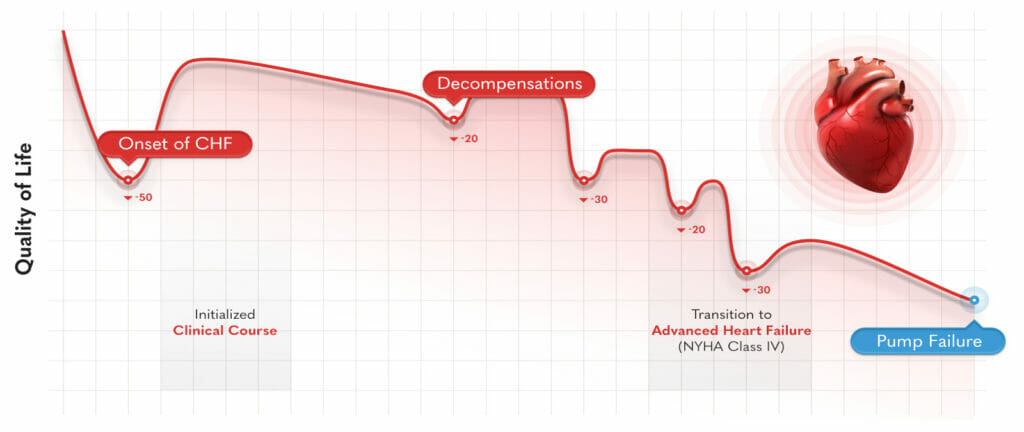
How Active Hospice Helps with the Ups and Downs of Heart Failure
The unpredictability of heart failure leaves many unprepared for the end of life. Choosing hospice for heart failure management helps you feel better prepared and enables you and your loved ones to get the closure you desire.
Heart failure refers to a condition in which the heart cannot adequately deliver oxygenated blood to meet the body’s needs. Also commonly referred to as congestive heart failure, this condition usually occurs as a complication of some other disease, most commonly from hypertension, ischemic heart disease, hyperlipidemia, and diabetes. These diseases damage the heart tissue and muscle. This damage causes the heart to pump less effectively, causing fluid to back up behind the heart.
Age is one of the biggest risk factors as evidenced by the fact that the incidence of heart failure doubles with each decade lived. The population of Americans aged 65 and older is projected to grow from 58 million in 2021 to 88 million by 2050. Combine this with the decrease in mortality from other diseases that contribute to heart failure, like heart attacks and hypertension, and we will only see the number of heart failure cases rise in the future.
Unfortunately, heart failure is a chronic and progressive condition that worsens over time. Existing therapies can delay the disease progression, but very rarely do they reverse or stop it.
The Seesaw Trajectory of Heart Failure
Heart failure is commonly described as having a seesaw or up-and-down trajectory. Patients go through periods of controlled symptoms and periods of uncontrolled symptoms where heart function declines. With each cycle, cardiac function worsens until eventually the heart cannot function and a patient dies of pump failure.
Unfortunately, these cycles are unpredictable. Even in the late stages of heart failure, patients still have “good days”. After an exacerbation, they may even return to a level of function close to what existed before the decompensation. This can deceive patients and providers into procrastinating the hospice discussion. But remember, it is not possible to know which exacerbation will be fatal.
The unpredictable nature of heart failure causes patients to overestimate their expected longevity by an average of 40%. This leaves many heart failure patients unprepared as the disease progresses, waiting until the very end of the disease to enroll in hospice.
Hospice isn’t intended to just be used in the last few days of life. The benefits of hospice are intended to be used over the last 6 months of life.
When does a Person Qualify for Hospice?
CMS requirements for hospice care state that a patient must be classified as a New York Heart Association (NYHA) class IV. This means that a patient has symptoms of heart failure at rest and is unable to perform any amount of physical activity without discomfort despite optimal medical treatment. This coincides with studies that indicate that the average 1 year mortality rate of Stage IV heart failure is between 30-40%.
What might this look like? For patients with end stage heart failure, life is not easy. As mentioned above, life becomes a constant balancing act of trying to be active and not being able to because of shortness of breath and weakness. They often have trouble managing their edema, usually resorting to diet and fluid restrictions on top of diuretics to manage their swelling. In addition, patients with end stage heart failure often complain of increase heart rate, coughing, confusion, falls, chest pain, and increased levels of anxiety.
Current treatment goals for NYHA Class IV heart failure include controlling symptoms, improving quality of life, reducing hospital readmissions and ESTABLISHLING A PATIENT’S END-OF-LIFE GOALS. These discussions should occur at least annually to help simplify difficult decisions in the future and to align the patient’s expectations.
Managing Heart Failure with Active Hospice
Once the decision has been made to start hospice, therapies do not change very much. Symptomatic treatment of heart failure coincides with the medications that the patient has been taking to slow the progression. Symptom management for heart failure tends to improve once hospice services begin. In fact, patients who elect hospice to help manage heart failure, on average, live 81 days longer than those not on hospice

Why Choose Active Hospice?
The uncertainty associated with heart failure leaves patients unprepared to face life’s final journey. 90% of patients prefer to pass away at home, but among patients with heart failure, only 29% do. Active Hospice provides you and your loved ones with the quality, comfort, and control over the end of life experience. Our care team empowers you and your family to attain a sense of closure. We enable you to create lasting memories and more enjoyable moments.
Don’t let the ups and downs of heart failure guide your life decisions any longer. Take back control with Active Hospice! Call today to schedule your free, in-home consultation.



